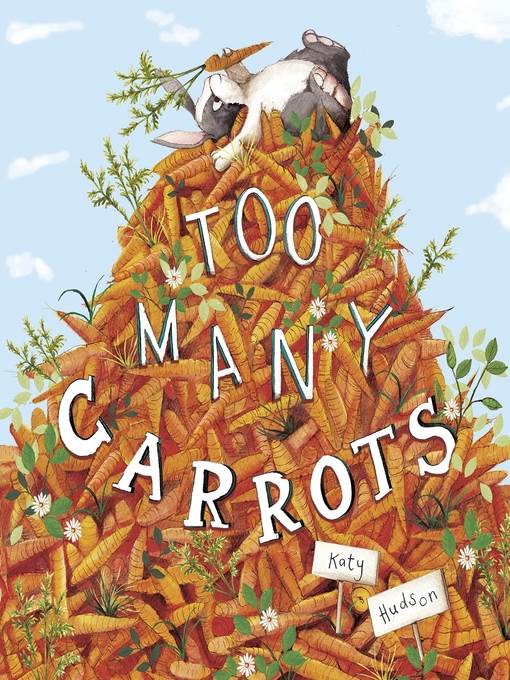
Too Many Carrots
فرمت کتاب
ebook
تاریخ انتشار
2016
Lexile Score
510
Reading Level
0-2
ATOS
2
Interest Level
K-3(LG)
نویسنده
Katy Hudsonناشر
Capstoneشابک
9781623706401
کتاب های مرتبط
- اطلاعات
- نقد و بررسی
- دیدگاه کاربران
نقد و بررسی

November 23, 2015
Hudson (Bear and Duck) handily juggles profuse visual humor and a passel of life lessons, including taking only what you need, sharing what you have, and not taking advantage of friends. Greed, rather than gluttony, is the crux of Rabbit’s problem: he does more hoarding of carrots than eating them, until his burrow overflows to the point that he’s forced out. Luckily, Rabbit has several generous friends who offer to share their homes—offers that Rabbit happily accepts. “Maybe it’s a little too snug for two?” suggests Tortoise, as Rabbit climbs into his shell. “Not at all,” replies an oblivious Rabbit. After cracking Tortoise’s shell, Rabbit moves from one nervous host to the next, his stash of carrots destroying each home. Simultaneously sassy and sweet, Hudson’s illustrations place her cast of cuddly, expressive animals in a variety of slapstick situations. It’s unsurprising but still satisfying when Rabbit’s conscience finally kicks in; taking responsibility for the mayhem he’s caused, he opens his home to his friends. When life gives you carrots, Hudson suggests, make carrot cake (and juice and soup and cupcakes). Ages 3–5.

May 1, 2016
PreS-Gr 1-Carrot-obsessed Rabbit enjoys collecting his favorite vegetable to the point that his den is so crowded with carrots that there isn't enough room for him. Rabbit sets out to solve his problem. Tortoise offers to share his shell with Rabbit. Rabbit (along with a dozen obligatory carrots) squirms into Tortoise's shell, and Tortoise's shell cracks. Now Tortoise and Rabbit both need a place to sleep, so they ask Bird. After three bodies and a load of carrots are stashed into Bird's nest, the branch breaks. The three homeless friends move in with Squirrel. After Rabbit fills Squirrel's tree with carrots, there is no room for the four of them. So the story goes until Rabbit feels so bad that he has made so many of his forest friends homeless that he invites everyone back to his den to stay and share his delicious cache of carrots. Hudson's watercolor and ink illustrations are sprinkled with fun details, like house signs. The critters' faces are as expressive as they are cute, adding feeling to the dialogue-heavy storytelling. Children will empathize with Rabbit's need to collect and keep his favorite things near him at all times. They may even think a bit about sharing, the ultimate message of the book. VERDICT This entertaining addition is suitable for sharing one-on-one or in a group.-Mindy Hiatt, Salt Lake County Library Services, UT
Copyright 2016 School Library Journal, LLC Used with permission.

December 15, 2015
When Rabbit's unbridled mania for collecting carrots leaves him unable to sleep in his cozy burrow, other animals offer to put him up. But to Rabbit, their homes are just more storage space for carrots: Tortoise's overstuffed shell cracks open; the branch breaks beneath Bird's nest; Squirrel's tree trunk topples over; and Beaver's bulging lodge collapses at the first rainstorm. Impelled by guilt and the epiphany that "carrots weren't for collecting--they were for SHARING!" Rabbit invites his newly homeless friends into his intact, and inexplicably now-roomy, burrow for a crunchy banquet. This could be read (with some effort) as a lightly humorous fable with a happy ending, and Hudson's depictions of carrot-strewn natural scenes, of Rabbit as a plush bunny, and of the other animals as, at worst, mildly out of sorts support that take. Still, the insistent way Rabbit keeps forcing himself on his friends and the magnitude of the successive disasters may leave even less-reflective readers disturbed. Moreover, as Rabbit is never seen actually eating a carrot, his stockpiling looks a lot like the sort of compulsive hoarding that, in humans, is regarded as a mental illness. Superficially appealing; much less so upon closer examination. (Picture book. 6-8)
COPYRIGHT(2015) Kirkus Reviews, ALL RIGHTS RESERVED.

























دیدگاه کاربران